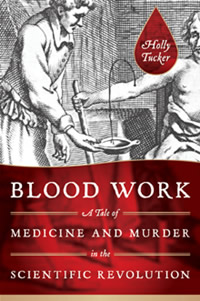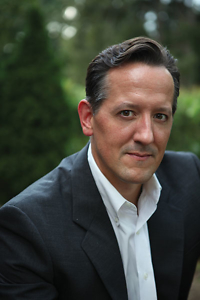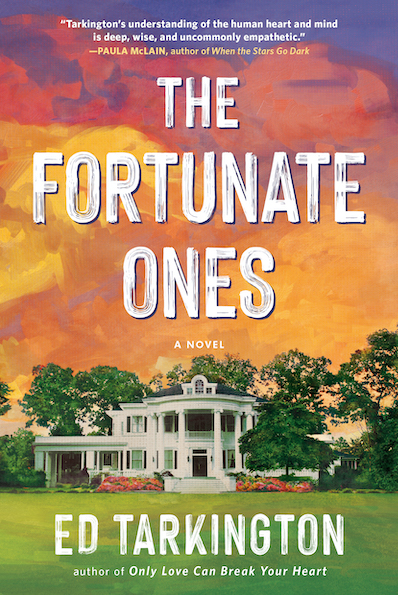First Blood
Holly Tucker talks with Chapter 16 about the macabre history of blood transfusion
By the second half of the seventeenth century, decades of scientific experimentation and invention had led to some of the greatest discoveries the world had seen since ancient Greece: gravity, microbes, the rings of Saturn, and countless other wonders. New discoveries seemed to pop up daily, making celebrities of their discoverers, who could move from abject poverty to royal courts by virtue of their scientific prowess. This time of unbridled enthusiasm for innovation was also a time when the most common medical remedy for a variety of ailments was bloodletting, so it is no wonder that competing physicians would turn their attention to the nature of blood. Holly Tucker, an associate professor at Vanderbilt, reveals their often gruesome experiments in blood transfusion—and a highly public murder trial that resulted from them—in her new book, Blood Work: A Tale of Medicine and Murder in the Scientific Revolution. She recently answered questions from Chapter 16 via email about the grim beginnings of a modern life-saving practice.
Chapter 16: What first drew you to this bloody tale?
Tucker: I stumbled on the story of early blood transfusions several years ago while working up lecture notes for a class on William Harvey’s 1628 discovery of blood circulation. I was immediately fascinated—and not just because these first transfusions, which began in 1667, used animals as donors for humans. I was also intrigued that historians had not said more about the court case and murder accusations that followed them. While Jean-Baptiste Denis was not found guilty of murdering his transfusion patient, the courts effectively outlawed transfusion research. Past historical research claimed that the ban was because early transfusions were so dangerous—taking place as they did nearly 150 years before antisepsis and nearly 250 years before the discovery of blood groups. The court ruling nonetheless mentioned that several physicians had framed Denis for the murder. They were never taken to trial. But this made me wonder if there was much more to the story. And after five years of research, all I can say is: And how!
 Chapter 16: At times Jean-Baptiste Denis seems a deeply sympathetic character, and at other times his actions seem horrifying, at least by modern standards. What are your own thoughts about him? Did they change any during the course of your research?
Chapter 16: At times Jean-Baptiste Denis seems a deeply sympathetic character, and at other times his actions seem horrifying, at least by modern standards. What are your own thoughts about him? Did they change any during the course of your research?
Tucker: You’re right; Denis is deeply complex character—and someone who was fascinating to write about. I admire him because he worked so hard to beat the odds. Denis was outsider to the closed world of early French medicine. As someone of humble birth, he did not have the pedigree that would have allowed him to take his training at the elite University of Paris Medical School. Instead, he studied at the University of Montpellier, a rival school for which Paris physicians had little respect. Still, his will to succeed is also wrapped into a palpable sense of pride and arrogance—an attitude that was also at the heart of some of the brutal animal and human experiments that he performed. If we both marvel and shudder at a man like Denis, I think it’s a reflection not as much of the man himself, but rather of the period in which he was living. So many of the more well-known characters of the scientific revolution shared Denis’s “in it to win it” attitude.
Chapter 16: Speaking of research, Blood Work contains an impressive bibliography and prodigious notes. Could you describe the process of hunting down source material for the book? What survives of those early transfusion experiments? What were some of the surprises along the way?
Tucker: To be honest, I felt a lot like Sherlock Holmes! I knew there had been a murder. But why? What was it about blood transfusion that would lead someone to kill to stop the procedure in its tracks? This led me to read everything I could get my hands on about early blood science—and the competing scientific, political, philosophical, and religious beliefs that swirled around it. From there, I compiled a list of suspects. Who had a stake in stopping Denis? It turns out that none of the prime suspects on my list was involved. So I spent a lot of time in archives in Paris, London, and Rome. And it was during one those many trips that I found the smoking gun: a single letter written by a lawyer who was not involved in the trial but who was apparently outraged by the conspiracy. He named the murderous physicians—and once I had those names, I was stunned by how many clues they had left out in the open just waiting, almost proudly it seemed, to be discovered.
Chapter 16: The book portrays a system of patronage whereby kings and nobles seeking to improve their reputations supported what amounted to personal stables of scientists. How did that system affect the research accomplished? Are any similar forces at work in the types of scientific patronage that exist today?
 Tucker: Just as today, there was a delicate balance between imagining scientific possibilities and finding the money to pay for it. And while a line of research may seem promising, few people will pursue it if it is unlikely to receive funding or support. Had Jean-Baptiste Denis tried to get support for his blood research even ten years earlier, I don’t think there would have been a story to tell. Unlike the English who were hard at work exploring the implications of blood circulation, the French scientific community was more focused on astronomy in the 1650s. Denis’s patron, Henri de Montmor, had his sights set on nurturing the astronomer Christian Huygens, who would go on to become something of an international superstar. Montmor gave up his astronomical aspirations and turned to blood research only after Louis XIV founded the French Academy of Sciences, taking all of the nobleman’s stars—including Huygens—with him. So just as scientists pursued work that was most likely to receive funding, so too were the patrons who funded them deeply interested in what would give them the most fame.
Tucker: Just as today, there was a delicate balance between imagining scientific possibilities and finding the money to pay for it. And while a line of research may seem promising, few people will pursue it if it is unlikely to receive funding or support. Had Jean-Baptiste Denis tried to get support for his blood research even ten years earlier, I don’t think there would have been a story to tell. Unlike the English who were hard at work exploring the implications of blood circulation, the French scientific community was more focused on astronomy in the 1650s. Denis’s patron, Henri de Montmor, had his sights set on nurturing the astronomer Christian Huygens, who would go on to become something of an international superstar. Montmor gave up his astronomical aspirations and turned to blood research only after Louis XIV founded the French Academy of Sciences, taking all of the nobleman’s stars—including Huygens—with him. So just as scientists pursued work that was most likely to receive funding, so too were the patrons who funded them deeply interested in what would give them the most fame.
Chapter 16: To what degree did the rivalry between England and France drive the transfusion race? How important was the rise of the scientific journal in fueling the experimentation?
Tucker: In many ways, I see the French and English rivalries as being at the heart of early transfusion research. French physicians were overwhelmingly against the idea of circulation (which was a precursor to transfusion research). But they couldn’t sit idly by as the English were claiming that they had successfully done the unthinkable: they had transfused the blood of one animal into another. This rivalry was fueled by the rise of the scientific journal. Research results could now be shared more quickly to a broader readership, both at home and abroad. While science had long been a game of one-upmanship, the stakes of the competition became suddenly more important as the long-standing wars between the two countries began to include not only what happened on the battlefields but also what happened in experiment rooms.
Chapter 16: How would you respond to readers who are troubled by the book’s scenes of animal experimentation—especially on dogs?
Tucker: Those scenes were really hard to write—doubly hard because often my own dog was sleeping at my feet as I wrote! Seventeenth-century lab reports are often very detailed, which meant that I did not have the luxury of skimming over the details. The experimenters clearly wanted their readers to see and hear what they did, so I felt that I had a responsibility to use those documents to tell the story in ways that would also help my modern readers feel like they were there too.
The fact of the matter is that animal vivisection had only recently entered scientific practice. René Descartes and other philosophers had opened the door to the possibility in claims that animal bodies were little more than soulless machines. If animal experimentation during this era seemed like a horrific and painful hodge-podge, it was because the era was far from making full sense of what it all meant—and where the bioethical limits were going to be.
Chapter 16: I understand you are currently involved in less gruesome work connected to blood transfusion. Could you describe it?
Tucker: I’m a regular volunteer at the Nashville Area Red Cross and have been focusing lately on an online event called “Writers for the Red Cross,” which celebrates Red Cross Month in March. Authors, agents, editors, and independent bookstores are coming together as a community to support the Red Cross, which provides comfort to communities across the nation and beyond. We have over 170 writers, agents, and editors participating—as well as nearly twenty bookstores. Liza Donnelly of The New Yorker did the logo art. We have people like Sara Gruen, Mary Roach, and Rosanne Cash on board. And to my delight, we just learned that Craig Ferguson of the “Late, Late Show” is donating a “swag bag” for the auction. It’s a huge undertaking, especially because it comes just as the book releases. But it’s truly a labor of love for a cause that I care deeply about.
To read Chapter 16’s review of Blood Work, click here.
Holly Tucker will discuss and sign copies of Blood Work: A Tale of Medicine and Murder in the Scientific Revolution on March 2 at 11:30 a.m. in the main Nashville Public Library. The event is part of the Thinking Out of the (Lunch) Box series, a joint venture of Vanderbilt University and the Nashville Public Library. At 11:30 a.m., lunch is served. At noon, the program begins. The event is free and open to the public.




